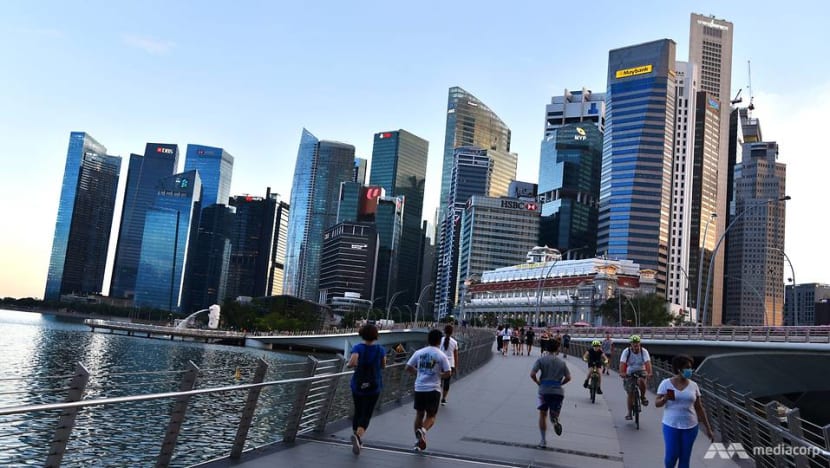‘Green shoots’ of recovery for Singapore’s economy, although uncertainties remain: Economists

The Singapore city skyline as seen from Jubilee Bridge (Photo: Jeremy Long)
SINGAPORE: With better-than-expected data showing the economy back in expansion mode for the first quarter of 2021, economists said “green shoots” of recovery are emerging for Singapore following a year in the doldrums due to the COVID-19 pandemic.
Gross domestic product (GDP) grew 0.2 per cent year-on-year in the January to March period, according to flash estimates from the Ministry of Trade and Industry (MTI) on Wednesday (Apr 14).
The gains, albeit marginal, marked the economy’s first quarterly growth since the pandemic erupted and beat expectations for a 0.2 per cent contraction in a Reuters poll.
READ: Singapore economy grows 0.2% in Q1, first expansion since COVID-19 outbreak
Economists also noted more optimism from the Singapore central bank, which released its half-yearly policy review on the same day.
While the Monetary Authority of Singapore (MAS) left its monetary policy stance unchanged, it said Singapore’s economy is “likely to exceed the upper end” of an official forecast for growth to be between 4 and 6 per cent this year, barring a setback to global growth.
It also noted firmer global growth prospects and how that has strengthened business and consumer confidence, leading to quicker growth in production and spending.
These, according to Maybank Kim Eng economists, painted “a far more upbeat assessment” compared to the central bank’s last policy review in October last year.
Economists also pointed to a “nuanced, yet notable” omission in the central bank’s policy statement. While the MAS reiterated its view that an “accommodative policy stance remains appropriate”, it left out the phrase “for some time” this time round.
“What this means is that as the recovery unfolds, the MAS is, at the margin, taking a more state-dependent view on maintaining accommodation rather than a time-assured stance, which is probably more appropriate when economic stress and uncertainty are greater,” said a note from Mizuho Bank.
READ: MAS leaves monetary policy unchanged amid COVID-19 uncertainties, low inflation
“GREEN SHOOTS” AS MANUFACTURING POWERS ON
Making the most gains in the first quarter was the manufacturing sector, which grew 7.5 per cent year-on-year. Accounting for about one-fifth of Singapore’s economy, the sector has been a bright spot in the pandemic-fuelled downturn, and economists said its outlook remains buoyant.
This is largely due to growth in clusters such as precision engineering, biomedical manufacturing and electronics, which have benefited from the boom in electronics demand as businesses look to digital solutions in a post-COVID world, said DBS senior economist Irvin Seah.
Further adoption of 5G networks, continued proliferation of emerging technologies such as artificial intelligence, and the introduction of new smartphone models and wearable devices will also continue to fuel demand for high-end electronics parts and components.
These will bode well for the local manufacturing sector, although ongoing global shortages of semiconductor chips “could pose a hindrance to achieving higher pace of expansion” in the near term, Mr Seah said.
READ: Singapore aims to grow manufacturing sector by 50% over next 10 years
Services, which include the pandemic-hit sectors like transportation and storage, continued to shrink in the first quarter but at a smaller magnitude of 1.2 per cent year on year. This part of the economy declined 4.7 per cent in the preceding quarter.
Construction also posted a smaller contraction – down 20.2 per cent, compared with an earlier 27.4 per cent decline in the fourth quarter of last year.
“Notwithstanding the negative prints, the pace of contraction in (services and construction) tapered from Q4 2020 levels, suggesting improved performance since the trough in the second quarter (of 2020),” said UOB economists in a note.
Overall, the flash estimates for the first quarter indicate that a “green shoots recovery is evident”, according to OCBC’s head of treasury research and strategy Selena Ling.
The better-than-expected data have prompted experts from at least two financial houses to raise their growth forecasts for Singapore this year.
Maybank Kim Eng economists Chua Hak Bin and Lee Ju Ye are penciling in full-year growth of 6.2 per cent, up from 4.5 per cent, due to factors such as improvements in the global economic outlook and a rapid roll-out of vaccines.
Even more upbeat is Barclays Bank economist Brian Tan, who revised his forecast from 6 per cent to 7.5 per cent growth.
“With the COVID-19 outbreak still under control, the economy remains on the mend. That said, our 7.5 per cent growth forecast partly reflects favourable base effects following last year’s contraction of 5.4 per cent, and is still unlikely to close the negative output gap,” he said.
READ: Singapore's overall unemployment rate falls for fourth straight month in February
PROCEED WITH CAUTION
That said, uncertainties remain and a recovery will most likely be a slow and uneven one, economists said.
The spread of the coronavirus continues in parts of the world, while the roll-out of vaccines remains slow. These could curb the reopening of international borders, and “persistent weakness” in the aviation, retail and hospitality sectors will hold back recovery, they added.
Apart from the pandemic, the geopolitical environment and global trade dynamics will also be key in determining Singapore’s growth this year, said UOB economists, who continue to expect a “K-shaped” economic recovery.
“While outward-facing industries are expected to perform well on the back of global growth recovery, the construction and services industries may continue to see headwinds especially if COVID-19 risks stay elevated globally,” they added.
READ: Commentary: Singapore economy set for V-shaped recovery this year but jobs market may take longer to rebound
Experts also said that despite tweaks in its policy statement and an upgrade to headline inflation forecasts, the central bank remains cautious.
OCBC’s Ms Ling pointed to how the MAS also raised concerns about a remaining negative output gap and “significant uncertainties” such as the possibility of further virus mutations.
“The open-ended statement about how 2021 GDP growth will likely exceed the upper end of the official 4 to 6 per cent forecast range without citing a revised range and a ‘significant uncertainties’ caveat could be implied to rein in any potential runaway economic optimism and premature monetary policy tightening expectations,” she said.
The central bank also said it expects core inflation, which is a key consideration for monetary policy, to “rise only gradually” this year and “remain short of its historical average”.
WHAT WILL MAS DO NEXT?
This is why the MAS will not be in a hurry to tighten monetary policy settings this year, some experts argued.
Morgan Stanley economists reckoned that policy tightening “is more likely a 2022 story, rather than a 2021 story”.
“This is because, despite the above-trend and above-consensus GDP growth rebound we are expecting for this year, the output gap would likely still remain negative this year even though narrowing. As such, domestic inflation would rise cyclically but still stay benign,” they wrote in a note.
READ: IN FOCUS: After COVID-19, where are the Singapore economy, workforce headed?
Similarly, Dr Chua and Ms Lee of Maybank Kim Eng expect the MAS to maintain a neutral policy come October to support the economic recovery. But they noted a 30 per cent probability of a tightening to a “slight appreciation bias”, given the risks of an inflation overshoot and stronger growth recovery.
For Mr Seah, the central bank’s next policy review will be data dependent.
“It will depend on the dynamics between growth and inflation, and overlay with the risk ahead, not just domestically but also externally,” said the DBS economist.
“On the flip side of the increasingly encouraging macro data, new variants of the virus, resurgence of the pandemic and the slow rollout of vaccines in some countries, including regional peers, are complicating the policy equation. Inflation is just one of the variables in this equation.”
BOOKMARK THIS: Our comprehensive coverage of the coronavirus outbreak and its developments
Download our app or subscribe to our Telegram channel for the latest updates on the coronavirus outbreak: https://cna.asia/telegram















